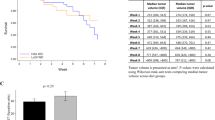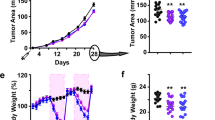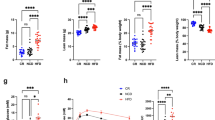Abstract
Selenium (Se) is known to regulate tumorigenesis and immunity at the nutritional and supranutritional levels. Because the immune system provides critical defenses against cancer and the athymic, immune-deficient NU/J nude mice are known to gradually develop CD8+ and CD4+ T cells, we investigated whether B and T cell maturation could be modulated by dietary Se and by tumorigenesis in nude mice. Fifteen homozygous nude mice were fed a Se-deficient, Torula yeast basal diet alone (Se−) or supplemented with 0.15 (Se+) or 1.0 (Se++) mg Se/kg (as Na2SeO4) for 6 months, followed by a 7-week time course of PC-3 prostate cancer cell xenograft (2 × 106 cells/site, 2 sites/mouse). Here, we show that peripheral B cell levels decreased in nude mice fed the Se − or Se++ diet and the CD4+ T cell levels increased in mice fed the Se++ diet. During the PC-3 cell tumorigenesis, dietary Se status did not affect peripheral CD4+ or CD8+ T cells in nude mice whereas mice fed with the Se++ diet appeared to exhibit greater peripheral CD25+CD4+ T cells on day 9. Dietary Se status did not affect spleen weight in nude mice 7 weeks after the xenograft. Spleen weight was associated with frequency of peripheral CD4+, but not CD8+ T cells. Taken together, dietary Se at the nutritional and supranutritional levels regulates peripheral B and T cells in adult nude mice before and after xenograft with PC-3 prostate cancer cells.




Similar content being viewed by others
Abbreviations
- Se:
-
Selenium
- Se−:
-
Selenium-deficient
- Se+:
-
Selenium-adequate
- Se++:
-
Selenium-supranutritional
References
Beck MA, Esworthy RS, Ho YS, Chu FF (1998) Glutathione peroxidase protects mice from viral-induced myocarditis. FASEB J 12:1143–1149
Gladyshev VN, Stadtman TC, Hatfield DL, Jeang KT (1999) Levels of major selenoproteins in T cells decrease during HIV infection and low molecular mass selenium compounds increase. Proc Natl Acad Sci USA 96:835–839
Arthur JR, McKenzie RC, Beckett GJ (2003) Selenium in the immune system. J Nutr 133:1457S–1459S
Shrimali RK, Irons RD, Carlson BA, Sano Y, Gladyshev VN, Park JM, Hatfield DL (2008) Selenoproteins mediate T cell immunity through an antioxidant mechanism. J Biol Chem 283:20181–20185
Hoffmann FW, Hashimoto AC, Shafer LA, Dow S, Berry MJ, Hoffmann PR (2010) Dietary selenium modulates activation and differentiation of CD4+ T cells in mice through a mechanism involving cellular free thiols. J Nutr 140:1155–1161
Qi Y, Schoene NW, Lartey FM, Cheng WH (2010) Selenium compounds activate ATM-dependent DNA damage response via the mismatch repair protein hMLH1 in colorectal cancer cells. J Biol Chem 285:33010–33017
Zeng H (2009) Selenium as an essential micronutrient: roles in cell cycle and apoptosis. Molecules 14:1263–1278
Seo YR, Kelley MR, Smith ML (2002) Selenomethionine regulation of p53 by a ref1-dependent redox mechanism. Proc Natl Acad Sci USA 99:14548–14553
Wu M, Kang MM, Schoene NW, Cheng WH (2010) Selenium compounds activate early barriers of tumorigenesis. J Biol Chem 285:12055–12062
Lu J (2001) Apoptosis and angiogenesis in cancer prevention by selenium. Adv Exp Med Biol 492:131–145
Schrauzer GN (2009) Selenium and selenium-antagonistic elements in nutritional cancer prevention. Crit Rev Biotechnol 29:10–17
Li GX, Lee HJ, Wang Z, Hu H, Liao JD, Watts JC, Combs Gr Jr LuJ (2008) Superior in vivo inhibitory efficacy of methylseleninic acid against human prostate cancer over selenomethionine or selenite. Carcinogenesis 29:1005–1012
Lippman SM, Klein EA, Goodman PJ, Lucia MS, Thompson IM, Ford LG, Parnes HL, Minasian LM, Gaziano JM et al (2009) Effect of selenium and vitamin E on risk of prostate cancer and other cancers: the Selenium and Vitamin E Cancer Prevention Trial (SELECT). JAMA 301:39–51
Sharkey FE, Fogh J (1984) Considerations in the use of nude mice for cancer research. Cancer Metastasis Rev 3:341–360
Kennedy JD, Pierce CW, Lake JP (1992) Extrathymic T cell maturation. Phenotypic analysis of T cell subsets in nude mice as a function of age. J Immunol 148:1620–1629
Holmstrom A, Wu RTY, Zeng H, Lei KY, Cheng WH (2011) Nutritional and supranutritional levels of selenate differentially suppress prostate tumor growth in adult but not young nude mice. J Nutr Biochem. doi:10.1016/j.jnutbio.2011.06.001
Rosenberg SA, Yang JC, Restifo NP (2004) Cancer immunotherapy: moving beyond current vaccines. Nat Med 10:909–915
Stewart TJ, Smyth MJ (2011) Improving cancer immunotherapy by targeting tumor-induced immune suppression. Cancer Metastasis Rev 30:125–140
Gajewski TF, Fuertes M, Spaapen R, Zheng Y, Kline J (2011) Molecular profiling to identify relevant immune resistance mechanisms in the tumor microenvironment. Curr Opin Immunol 23:286–292
de la Cruz-Merino L, Henao-Carrasco F, Garcia-Manrique T, Fernandez-Salguero PM, Codes-Manuel V (2009) Role of transforming growth factor beta in cancer microenvironment. Clin Transl Oncol 11:715–720
Kaech SM, Wherry EJ, Ahmed R (2002) Effector and memory T-cell differentiation: implications for vaccine development. Nat Rev Immunol 2:251–262
Shalev I, Schmelzle M, Robson SC, Levy G (2011) Making sense of regulatory T cell suppressive function. Semin Immunol. doi:10.1016/j.smim.2011.04.003
Yan L, Boylan LM, Spallholz JE (1991) Effect of dietary selenium and magnesium on human mammary tumor growth in athymic nude mice. Nutr Cancer 16:239–248
Roy M, Kiremidjian-Schumacher L, Wishe HI, Cohen MW, Stotzky G (1993) Selenium supplementation enhances the expression of interleukin 2 receptor subunits and internalization of interleukin 2. Proc Soc Exp Biol Med 202:295–301
Le Saux CJ, Teeters K, Miyasato SK, Hoffmann PR, Bollt O, Douet V, Shohet RV, Broide DH, Tam EK (2008) Down-regulation of caveolin-1, an inhibitor of transforming growth factor-beta signaling, in acute allergen-induced airway remodeling. J Biol Chem 283:5760–5768
Spyrou G, Bjornstedt M, Skog S, Holmgren A (1996) Selenite and selenate inhibit human lymphocyte growth via different mechanisms. Cancer Res 56:4407–4412
Hawkes WC, Kelley DS, Taylor PC (2001) The effects of dietary selenium on the immune system in healthy men. Biol Trace Elem Res 81:189–213
Zeng H, Jackson MI, Cheng WH, Combs GF Jr (2011) Chemical form of selenium affects its uptake, transport, and glutathione peroxidase activity in the human intestinal Caco-2 cell model. Biol Trace Elem Res 143:1209–1218
Zhang S, Luo Y, Zeng H, Wang Q, Tian F, Song J, Cheng WH (2011) Encapsulation of selenium in chitosan nanoparticles improves selenium availability and protects cells from selenium-induced DNA damage response. J Nutr Biochem. doi:10.1016/j.jnutbio.2010.09.014
Acknowledgments
We thank Dr. Xin He and Jing Hu for their help on statistical analyses.
Author information
Authors and Affiliations
Corresponding authors
Rights and permissions
About this article
Cite this article
Cheng, WH., Holmstrom, A., Li, X. et al. Effect of Dietary Selenium and Cancer Cell Xenograft on Peripheral T and B Lymphocytes in Adult Nude Mice. Biol Trace Elem Res 146, 230–235 (2012). https://doi.org/10.1007/s12011-011-9235-2
Received:
Accepted:
Published:
Issue Date:
DOI: https://doi.org/10.1007/s12011-011-9235-2




